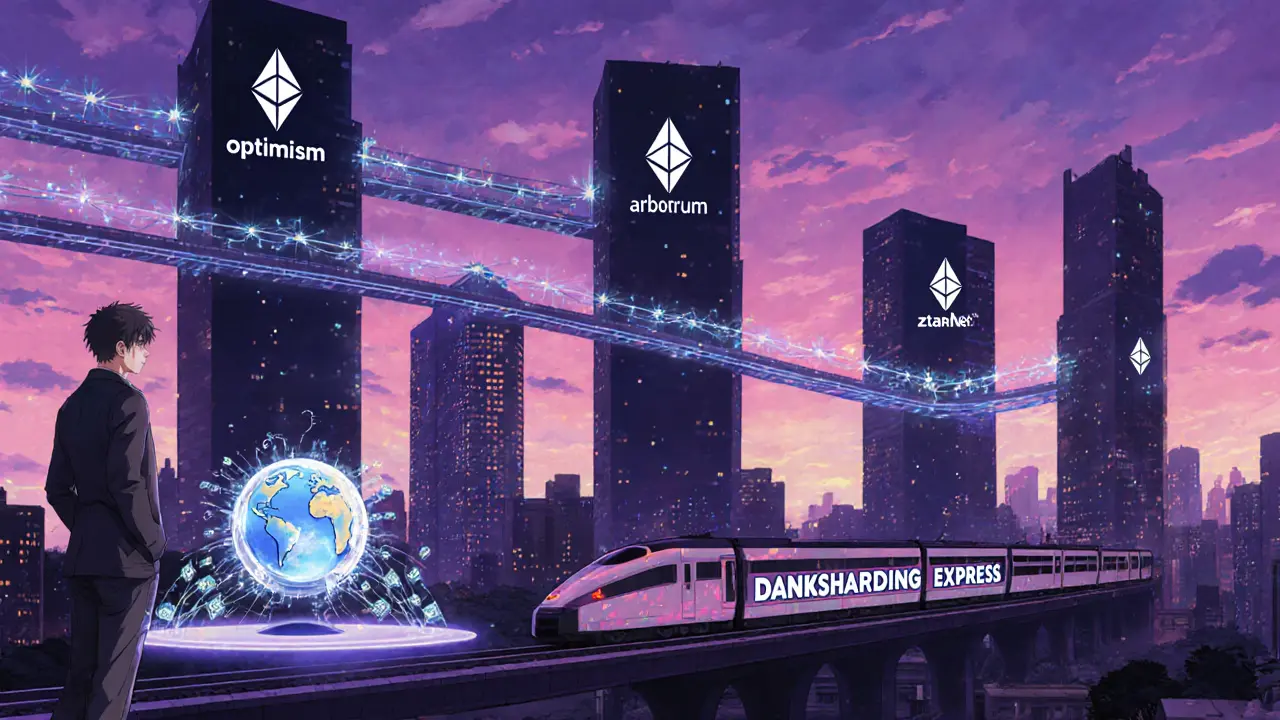L1-L2 Bridge Comparison Tool
Compare Bridge Architectures
Select a metric to view detailed comparisons between Optimistic Rollups, Zero-Knowledge Rollups, and State Channels
Quick Reference
Optimistic Rollup
Best for DeFi and large-scale dApps requiring composability
Fast deploymentZero-Knowledge Rollup
Ideal for gaming and NFTs requiring fast withdrawals
Instant finalityState Channel
Perfect for micropayments and private exchanges
Ultra-fast off-chainL1‑L2 Bridge is a protocol that connects a blockchain’s base layer (Layer 1) with its scaling solutions (Layer 2), enabling secure asset transfers and data exchange while inheriting the security of the main chain. In simple terms, a bridge lets the main chain talk to its faster side‑chains without losing the safety guarantees that made the main chain trustworthy in the first place.
Why the Bridge Matters
When Ethereum launched, its transaction throughput hovered around 15‑30 TPS and gas fees could spike to $15‑$50. Users soon demanded cheaper, faster swaps for DeFi, NFTs, and gaming. L1‑L2 bridge became the lifeline that lets developers ship those high‑speed experiences while keeping the core security of Ethereum’s proof‑of‑stake consensus.
Three Architectural Patterns Behind L1‑L2 Bridges
Not all bridges work the same way. Three patterns dominate the landscape, each with its own trade‑offs.
- Optimistic Rollup relies on fraud proofs and a challenge window during which anyone can dispute an incorrect state transition. Examples: Optimism and Arbitrum.
- Zero‑Knowledge Rollup uses succinct cryptographic proofs (zk‑SNARKs or zk‑STARKs) to convince the base chain that a batch of transactions is valid before it’s posted. Examples: zkSync and StarkNet.
- State Channel creates a private, off‑chain corridor between participants that only settles the final balance on Layer 1. Example: Connext.
Performance Snapshot (2023‑2024)
Across major Ethereum L2s, the bridge ecosystem moved over $42.7 billion in cumulative value by September 2023, handling roughly 1.2 million transactions per day. That translates to 2,000‑4,000 TPS on L2 versus 15‑30 TPS on L1, while gas drops from $15‑$50 down to $0.01‑$0.10.
Comparing the Three Patterns
| Metric | Optimistic Rollup | Zero‑Knowledge Rollup | State Channel |
|---|---|---|---|
| Finality Time | 7‑day challenge (can shrink to 4 hours with Arbitrum Nitro) | 10‑30 minutes (proof verification on‑chain) | Instant off‑chain; settlement on L1 only when channel closes |
| Security Model | Economic‑incentive; validators stake ETH (≈$1 M per node) | Cryptographic proof; ~300k‑500k gas per verification | Depends on channel participants; L1 settlement inherits main chain security |
| Throughput (TPS) | ~2,500‑3,500 | ~3,000‑4,500 | Up to 1,000,000 (closed‑test env) |
| Typical Use‑Case | DeFi & large‑scale dApps needing composability | Gaming, NFTs, fast withdrawals | Micropayments, private exchanges |

Security Nuances You Should Know
Optimistic rollups rely on a challenge period: anyone can post a fraud proof if a batch is malformed. This model works because validators stake large amounts of ETH; colluding with >33 % of stakes could theoretically compromise the bridge (Princeton’s 2023 attack‑vector analysis). Zero‑knowledge rollups avoid a challenge window altogether, but the correctness of the zk‑SNARK proof itself becomes the single point of trust. Verification costs about 300‑500 k gas per batch, which is still cheaper than posting the full data on L1.
State channels sidestep most on‑chain verification until settlement, making them ultra‑fast, yet they demand careful off‑chain state management. A data‑availability attack could freeze a channel’s ability to close, as demonstrated in Connext’s June 2023 benchmark where a 2‑hour outage caused temporary fund lock‑up.
Developer Experience: What’s Hard and What’s Easy
Getting a bridge up and running isn’t a weekend hobby. Most teams need 2‑4 weeks of focused development, a solid grasp of Solidity (minimum 6 months experience), and familiarity with Merkle proofs. For Optimism, hardware specs sit at 16 GB RAM and a 500 GB SSD; a full node syncs in roughly 12‑24 hours on consumer hardware. Arbitrum’s Nitro upgrade trimmed the challenge window but added an “interactive proving” step that can confuse newcomers.
Documentation quality varies: zkSync scores 4.7/5 for clarity, while StarkNet lags at 3.2/5, with many developers reporting “significant difficulty implementing withdrawal flows”. Community support helps - Optimism’s Discord hosts >127 k members with average response times under 22 minutes, but keep an eye on open issues: as of Oct 2023, Optimism had 247 open tickets about withdrawal timing.
Real‑World Adoption and Market Impact
Institutional money is flowing fast. By Oct 2023, TVL on Ethereum L2s topped $7.8 billion - 18 % of total Ethereum TVL. Optimism alone secured $1.84 billion, while Arbitrum held $3.71 billion. JPMorgan’s Onyx division now settles inter‑bank payments on an Optimism‑based L2, and Shopify leverages Polygon zkEVM (a zk‑rollup) for merchant payments.
Regulators are watching. The SEC flagged bridges as potential securities conduits, while Europe’s MiCA framework explicitly exempted L1‑L2 bridges because they inherit Layer 1 security. That regulatory nuance makes L1‑L2 bridges more attractive for compliance‑focused enterprises.

Future Directions: Faster Withdrawals and Layer 3
Developers are aggressively shrinking withdrawal windows. Arbitrum’s Stylus upgrade (target Q1 2024) aims for a 4‑hour challenge period, and Optimism’s retro‑public‑goods fund is financing sub‑24‑hour research. Ethereum’s upcoming Danksharding upgrade (expected 2024‑2025) should solve the data‑availability bottleneck, boosting bridge throughput by 30‑50 %.
The next frontier is Layer 3 - application‑specific chains that sit atop L2s and connect via standardized bridges. StarkWare’s CEO describes Layer 3 as an “application‑specific hierarchy” that could make cross‑L2 interoperability seamless, turning today’s walled‑garden L2s into a fluid ecosystem.
Quick Takeaways
- L1‑L2 bridges inherit main‑chain security while delivering 100‑200× faster, cheaper transactions.
- Optimistic rollups trade speed for a challenge window; zk‑rollups offer instant finality at higher verification gas cost.
- State channels excel at micropayments but require careful off‑chain coordination.
- Security concerns focus on validator collusion (optimistic) and proof correctness (zk‑rollup).
- Regulatory landscape treats L1‑L2 bridges more favorably than generic cross‑chain bridges.
Frequently Asked Questions
What is the main advantage of an L1‑L2 bridge over a regular cross‑chain bridge?
A regular cross‑chain bridge connects two independent blockchains, each with its own security model. An L1‑L2 bridge, on the other hand, inherits the security guarantees of the base chain, so assets stay protected by Ethereum’s consensus while enjoying L2 speed and low fees.
Why do optimistic rollups still have withdrawal delays?
Optimistic rollups publish transaction batches without immediate proof. The 7‑day (or reduced) challenge period lets anyone submit a fraud proof if the batch is invalid. Until that window closes, the bridge cannot guarantee that the state is correct, so withdrawals are held.
Can I move assets directly from Optimism to Arbitrum?
Not directly. Both are L2s on Ethereum, but each has its own bridge contract. You must first withdraw to Layer 1 (Ethereum mainnet) and then deposit into the target L2. Emerging “bridge‑to‑bridge” solutions aim to shortcut this, but they are still experimental.
What hardware do I need to run my own L2 bridge node?
A typical Optimism or Arbitrum full node requires at least 16 GB RAM, a 500 GB SSD, and a stable 100 Mbps internet connection. Syncing the node can take 12‑24 hours on consumer hardware. For zk‑rollups, the storage demand is lower because the rollup data is compressed before posting to L1.
How do regulators view L1‑L2 bridges?
In the U.S., the SEC treats bridges as potential securities conduits, so projects may need to file disclosures. The EU’s MiCA framework, however, exempted L1‑L2 bridges from many cross‑chain rules because they inherit the parent chain’s security, making them more compliant in Europe.
Whether you’re a developer building the next DeFi dApp or an investor gauging the long‑term viability of Ethereum scaling, understanding how L1‑L2 bridges work - and where they’re headed - is essential. The bridge is the quiet workhorse that lets the ecosystem grow without sacrificing the trust that made crypto popular in the first place.











Rampraveen Rani
October 26, 2025 AT 20:33 PM🚀 L1‑L2 bridges are the turbo boost for Ethereum! They let you move assets fast and cheap 😎 No more waiting forever for withdrawals.
Dimitri Breiner
October 26, 2025 AT 23:03 PMGreat breakdown! For developers, remember that Optimistic rollups need to budget for the challenge window while zk‑rollups give you near‑instant finality. Keep testing your withdrawal flows early to avoid nasty surprises.
Karla Alcantara
October 27, 2025 AT 01:33 AMReally uplifting read! The way bridges inherit Ethereum’s security while delivering massive speed gains feels like a win‑win for the whole community. It’s exciting to see projects like Optimism and zkSync paving the way for more inclusive finance.
Jessica Smith
October 27, 2025 AT 04:03 AMAnother thing the post glosses over is the hidden risk of validator collusion. If a few whales control the stake they can cripple the bridge. That's why you should stay skeptical.
Petrina Baldwin
October 27, 2025 AT 06:33 AMThe bridge gas costs have dropped dramatically.
Ralph Nicolay
October 27, 2025 AT 09:03 AMIndeed, the reduction in gas fees is a significant development in the Ethereum scaling narrative. However, it remains essential to evaluate the trade‑offs associated with each bridging architecture, particularly concerning security guarantees and latency characteristics.
sundar M
October 27, 2025 AT 11:33 AMWhoa! The performance numbers in the article are mind‑blowing-millions of TPS on state channels feels like science fiction! It's amazing how far we've come from those early days of $50 gas fees 😍
Nick Carey
October 27, 2025 AT 14:03 PMSure, but do we really need another layer of complexity? Most users just want cheap swaps, not a whole new tech stack. Meh.
Sonu Singh
October 27, 2025 AT 16:33 PMYo fam, diving into L1‑L2 bridges is like opening a Pandora box full of hype and headaches.
First off, the security model of Optimistic rollups hinges on a huge stake pool, which sounds solid until you realize a few big players could sway the outcome.
Then you got zk‑rollups, which brag about zero‑knowledge proofs but those proofs cost a chunk of gas and need mad math skills.
State channels are slick for micropayments, yet they demand perfect off‑chain coordination-a single glitch can freeze funds.
The data‑availability concerns mentioned in the article are real; if the data isn’t posted correctly, withdrawals stall and users get anxious.
I’ve seen projects scramble for weeks to patch a faulty bridge contract, which hurts confidence big time.
On the dev side, you’re looking at weeks of work just to get a basic bridge up, not counting the endless debugging of Merkle proofs.
Also, the hardware requirements-16 GB RAM, half‑terabyte SSD-are not exactly laptop‑friendly for hobbyists.
Documentation varies wildly; zkSync’s guides are clean while StarkNet’s feel like reading ancient scrolls.
Community support can be a lifeline, but even active Discords have backlog on critical tickets.
Regulatory eyes are now on bridges, and the SEC’s stance could change the game overnight.
Despite all that, the upside is massive: 100‑200× faster transactions unlock use‑cases we only dreamed of yesterday.
Keep an eye on upcoming Danksharding; it promises to ease the data bottleneck and boost bridge throughput.
Bottom line: bridges are powerful, but treat them like any high‑risk financial tool-do your homework before you jump in.
Stay safe and keep building!
Peter Schwalm
October 27, 2025 AT 19:03 PMThanks for the honest breakdown! Your points about security trade‑offs and dev effort really hit home. Let’s keep sharing best practices to smooth out the onboarding curve for newcomers.
Marianne Sivertsen
October 27, 2025 AT 21:33 PMThe evolution of bridges reminds us that scalability and security are two sides of the same coin. As we chase speed, we must not lose sight of the trust that underpins the network. Thoughtful design will guide us forward.
Shruti rana Rana
October 28, 2025 AT 00:03 AMIndeed, the bridge ecosystem is entering a golden era 🌟. The synergy between L1 security and L2 agility promises unprecedented innovation. Let us celebrate this progress while staying vigilant 🛡️.
Stephanie Alya
October 28, 2025 AT 02:33 AMWow, another article telling us bridges are amazing 😑. Guess nothing changes.
olufunmi ajibade
October 28, 2025 AT 05:03 AMThis whole bridge hype is overblown. Who’s really benefiting from the reduced fees? The big projects or the average user? I demand transparency on the hidden costs!
Manish Gupta
October 28, 2025 AT 07:33 AMGood questions! The fees look tiny on‑chain, but the operator margins can be sizable. Plus, users still face latency during challenge periods.
Gabrielle Loeser
October 28, 2025 AT 10:03 AMYour observations are well‑taken. It is crucial to maintain rigorous audit standards when deploying bridge contracts. Continuous monitoring will ensure sustained security.
Cyndy Mcquiston
October 28, 2025 AT 12:33 PMSounds good